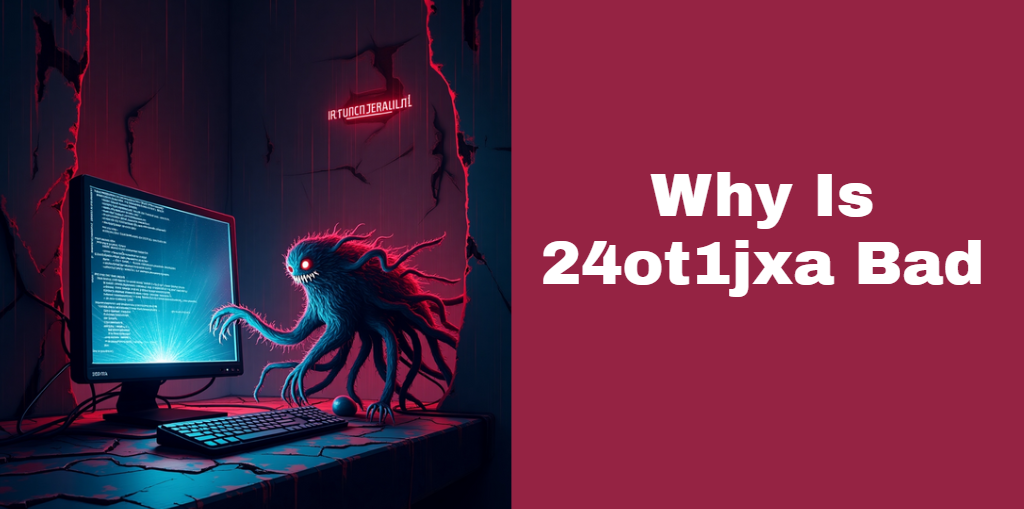Why Is 24ot1jxa Bad? Understanding the Hidden Dangers of This Stealthy Malware
The internet is filled with mysterious terms, but some carry serious consequences. One such term is “24ot1jxa,” which may look like a random combination of letters and numbers but actually points to a stealthy and dangerous form of malware.
For anyone who browses online, downloads files, or uses connected devices, understanding why 24ot1jxa is bad is essential. This malware is more than a nuisance—it’s a gateway to data theft, system compromise, and total loss of control over your device.
As cyber threats become more sophisticated, malware like 24ot1jxa have evolved beyond traditional detection. They hide in plain sight, exploit human error, and adapt to changing digital defenses. This guide explores what 24ot1jxa is, how it operates, and what you can do to protect yourself.
What Exactly Is “24ot1jxa”?
The term “24ot1jxa” has been identified as a signature or variant associated with advanced malware. It may appear in security logs, suspicious file names, or as part of a malicious payload embedded within software packages. It’s not just an odd string—it’s a digital fingerprint for something harmful.
This malware is particularly notorious for its polymorphic behavior, meaning it can change its code or structure to avoid detection. While antivirus software might catch common threats, polymorphic malware like 24ot1jxa slips through cracks, making it exceptionally dangerous.
The Nature and Behavior of 24ot1jxa
Understanding why 24ot1jxa is bad starts with recognizing its nature. It’s not a simple virus—it’s an advanced threat that combines elements of spyware, rootkits, and remote access tools (RATs).
It has the ability to:
- Morph its code to avoid detection
- Remain hidden in system files or processes
- Record keystrokes and screen activity
- Access microphones, cameras, and even network traffic
This level of control allows attackers to watch users without their knowledge, harvest credentials, and manipulate the infected device remotely.
How 24ot1jxa Spreads
Unlike traditional viruses that require active user download, 24ot1jxa uses a variety of stealthy methods to infect systems. These include:
Common Infection Vectors:
| Method | Description |
|---|---|
| Phishing Emails | Users are tricked into clicking links or downloading infected attachments. |
| Fake Software Updates | Malicious programs disguised as legitimate updates. |
| Drive-by Downloads | Malware installs silently when a user visits a compromised website. |
| USB Devices | Infected USBs can auto-run the malware on connection. |
| Software Bundles | Hidden within other freeware or cracked software installers. |
Even the most cautious user can fall victim if their system lacks layered defenses and up-to-date threat detection.
Primary Risks and Damages
Now let’s break down the reasons why 24ot1jxa is bad by looking at the damages it can cause:
- Massive Data Theft
Once inside your system, the malware can extract everything from browser history and saved passwords to sensitive business files and banking information. - Performance Degradation
Infected systems often show signs like excessive CPU use, unexplained crashes, freezing, and constant pop-ups. This isn’t just annoying—it can halt productivity and damage hardware over time. - Backdoor Creation
24ot1jxa doesn’t just steal; it opens up backdoors for other malware to enter. These could be ransomware, spyware, or even crypto miners that drain your device’s resources. - Network-Level Threat
In corporate or home networks, one infected device can spread the malware to others, compromising entire systems and even external connections like cloud storage.
Why It’s Especially Hard to Detect
One of the key reasons why 24ot1jxa is bad is its stealth. It’s designed to be invisible, especially to traditional antivirus software. Here’s how:
Evasion Techniques:
- Polymorphism: The malware rewrites parts of its own code every time it runs.
- Rootkit Behavior: It hides in system-level processes to mask activity.
- Antivirus Tampering: It can disable real-time protection tools and prevent security updates.
This makes it exceptionally hard to catch unless you’re using behavioral-based endpoint detection tools.
Who’s at Risk?
The short answer is: everyone. But the level of risk varies based on your device usage.
At-Risk Groups:
| Group | Reason |
|---|---|
| Home Users | Often lack advanced security tools and click on risky links. |
| Small to Medium Businesses | Targeted due to weaker security infrastructure. |
| Large Enterprises | Attacked via third-party apps or employees’ devices. |
| Healthcare & Education | Handle sensitive data and often run outdated software. |
Even mobile devices are not safe if users install unverified apps or connect to unsecured networks.
Detecting Infection
Spotting 24ot1jxa is not easy, but signs do exist. If you notice any of the following, your device might be infected:
- Sluggish performance
- Unknown programs or background tasks
- Frequent crash reports or blue screens
- Internet data spikes even when idle
- Security settings mysteriously disabled
To confirm, you’ll need advanced diagnostic tools like Malwarebytes Premium, ESET, or enterprise-grade EDR platforms.
Removal and Recovery
Once you suspect an infection, time is of the essence. Here’s a recommended course of action:
Step-by-Step Recovery:
- Disconnect from the Internet to stop data leaks.
- Boot in Safe Mode to prevent the malware from running.
- Run a Full Malware Scan using specialized tools like HitmanPro or Norton Power Eraser.
- Manually Inspect System Files if you have the expertise.
- Delete suspicious entries in Task Manager and Registry Editor.
- Change all passwords on a clean device.
- Consider a full system wipe if the malware cannot be removed completely.
Always follow up by monitoring your financial accounts and digital identities.
Prevention Strategies
Prevention is the best defense. You can avoid falling victim to malware like 24ot1jxa by implementing good cybersecurity habits.
Best Practices to Stay Safe:
| Strategy | Benefit |
|---|---|
| Keep Software Updated | Fixes known vulnerabilities. |
| Use MFA (Multi-Factor Authentication) | Adds an extra layer of security. |
| Install Reliable Antivirus + Firewall | Detects threats in real-time. |
| Educate Users on Phishing | Reduces the chance of human error. |
| Backup Data Regularly | Enables recovery after attack. |
| Enable Email Filtering | Blocks suspicious attachments or links. |
The more layers you add, the harder it becomes for malware to succeed.
Case Study: A Real-World Incident
In a 2024 cybersecurity breach, a retail company fell victim to an attack linked to a 24ot1jxa-type malware. The infection began when an employee downloaded a fake invoice attachment.
Over the next 48 hours:
- All point-of-sale systems were compromised
- Customer payment data was exfiltrated
- A secondary ransomware strain encrypted key databases
The cleanup process took weeks and cost the company hundreds of thousands in damages and reputational loss. Their biggest mistake? No multi-layered security and outdated antivirus software.
Conclusion
To sum it up, why is 24ot1jxa bad? Because it combines the worst traits of spyware, ransomware, and rootkits—all in one malicious package. It steals data, crashes systems, spreads through networks, and stays hidden from antivirus tools. This makes it a dangerous threat to individuals and organizations alike.
Staying safe means staying informed. Regularly update your devices, avoid suspicious downloads, and use strong, modern security tools. Prevention is far easier—and far cheaper—than damage control.
Recommended Articles
Capturing Memories: Highland High School Class of 2023 Photos by Julian Cajigas
What is Educamos Somorrostro? A Complete Guide to the Platform Supporting Students and Families
Ultimate Guide to the 0.120 Jules Chemistry Answer Key: Everything Students Need to Know
Growth Ideas from Qyndorath: A Comprehensive Guide to Sustainable Success






